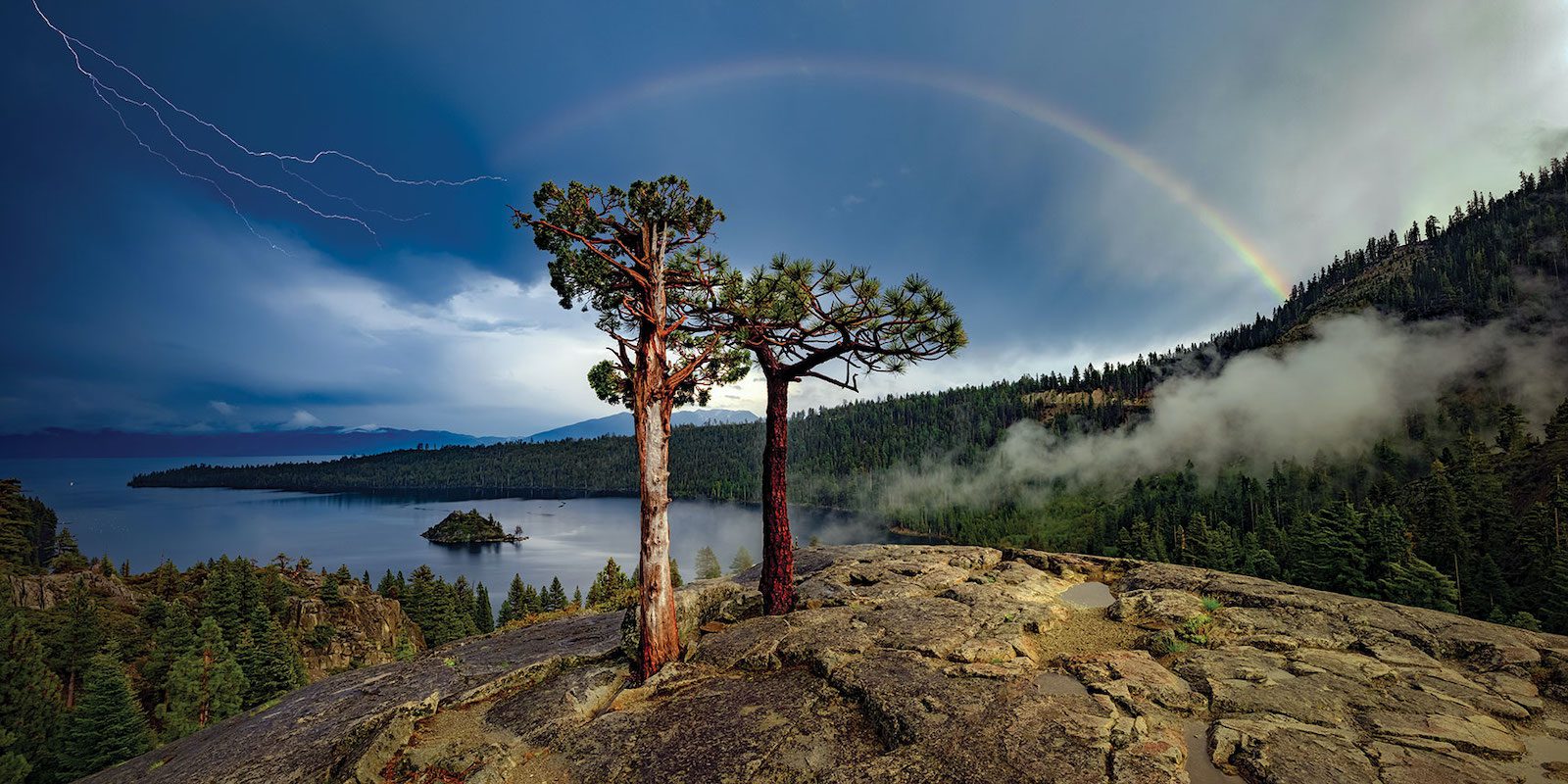
02 Jul Eye to Eye With Abe Blair
A local photographer rises to the top of a competitive profession through talent and determination
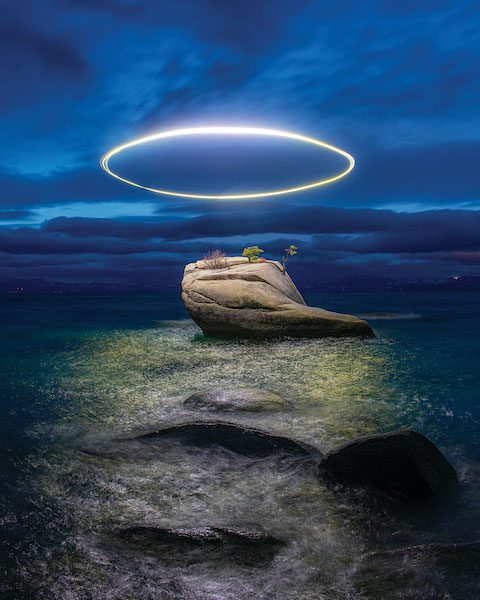
For this image, called King of The East, Blair used a drone to create the “crown” over Bonsai Rock in the blue hour of the evening
Here in Tahoe, where many a photographer has come to visit and never left, Abe Blair is held in high regard among the best of them.
His knack for the craft contributes to his sterling reputation. But beyond his sheer ability, Blair’s growing legend can be traced to his tireless work ethic and desire to improve—the result of a fire lit from within some 30 years ago, when a doctor’s prognosis did not align with his ambitions.
Fortunately for Tahoe Quarterly, Blair participates annually in the magazine’s Best of Tahoe Photo Contest, providing the opportunity to showcase his stunning work for our readers to enjoy. (He won three awards in this year’s contest and landed a memorable cover shot.)
We caught up with Blair in early May for a Q&A before his annual trip to Alaska, where he serves as a lead guide in a wild landscape teeming with giant brown bears.
Where were you born and raised, and what sort of things were you into as a kid?
I was born and raised in Portland, Oregon. I spent most of my time outside camping, fishing and playing sports like soccer, hockey, skateboarding and snowboarding.
How and when did you get into photography?
My parents were avid amateur photographers. They would always have cameras with them on every family trip and all the sporting events. When my grandma passed away, that was when I got my first SLR.
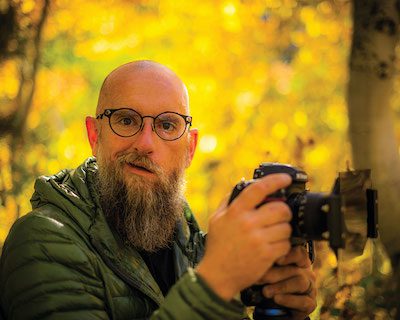
A rare shot of Abe Blair in front of the lens while capturing fall colors in North Lake Tahoe, photo by Moss Halliday
What was it about the craft that interested you as a youngster?
When I received my first SLR, I would take it fishing and snowboarding and had a lot of fun documenting the activities that my friends and I were doing. When I was a freshman in high school taking photography class, I got a full page published in a national skateboarding magazine. That was a catalyst for me to continue to try to work into the action sports world with photography.
What was your first camera?
My first camera was a Canon AE-1 with a 35mm-105mm zoom and a 50mm lens. When I started going to the Art Institute of Seattle, my father gave me his Hasselblad 503CW medium-format camera.
On your website, it mentions that you suffered a traumatic brain injury that resulted in temporary loss of vision in your left eye and the inability to walk, talk, hear out of your left ear or move the left side of your face. Could you share a little bit about this life-altering injury?
Before shattering my skull at the age of 18 in a go-kart accident, I was in the direction of choosing between joining the armed forces with hopes of the special forces or a half-ride soccer scholarship to Gonzaga University with a strong interest in engineering or architecture. After the injury, almost all the math skills I had learned in high school were gone along with other important pieces of education. My fallback became my love for photography and the outdoors. I pushed for a speedy recovery and about three years later was entering the world of professional snowboard and ski photography.
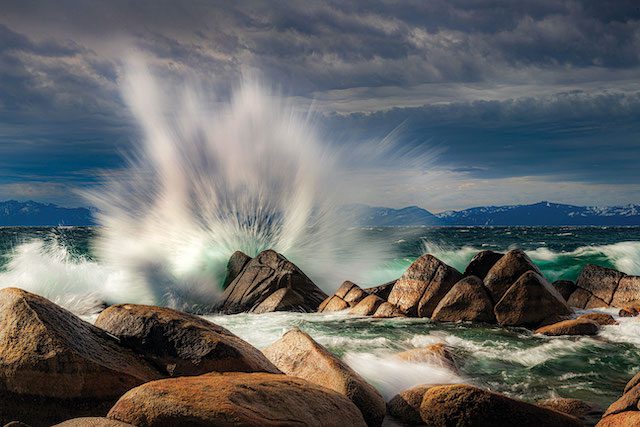
A massive wave crashes into rocks on Tahoe’s East Shore during a windstorm. Blair calls the image Ferocity
The next line in your story says you did not agree with your doctor’s prognosis of “a comfortable life on the couch,” which motivated you to recover and pursue your dream. Can you explain about the doctor’s prognosis—as well as the dream you chose to pursue?
Receiving this prognosis was devastating. Being confined to a hospital bed for four months before being released to my home, followed up with another 12 to 18 months of physical therapy, speech therapy and other therapies. I battled the hard choice of ending my life or pushing through these disabilities in hopes of proving everyone wrong and to myself that I could restore myself to a normal life.
Did you go on to study photography in college? If so, where?
About two years after the accident, I started to attend the Art Institute of Seattle to pursue a degree in digital commercial photography. The foundation I received was monumental for my knowledge of photography, but the school really pushed hard for me to conform to a traditional type of photography such as product, commercial, food and people, while I was only passionate about the action sports aspect of photography. I was called into the dean’s office and told I had to choose one of these four styles. I dropped out shortly after and two years later mailed him a copy of my first cover of an international snowboard magazine, along with many pages of editorial images.
During your formative years, did you have any mentors who helped you learn and grow as a photographer?
There were so many talented image makers in the ski and snowboard world. However, it was a very cutthroat world. I found inspiration every month the new issues would come out, but a few guys like Kevin Zacher, Tim Peare, Cole Barash and Chris Owens threw me a few bones and strong advice on how to navigate the industry.
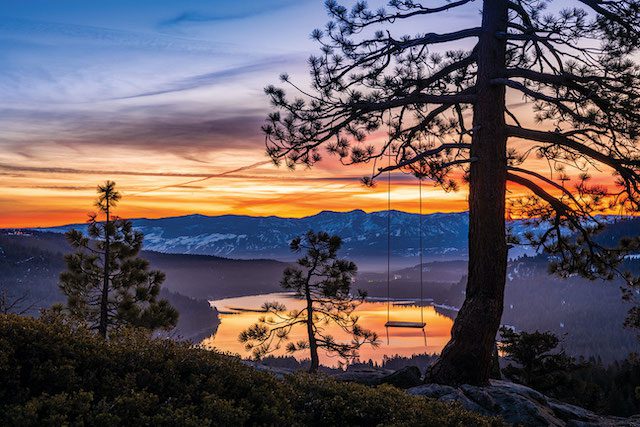
A backcountry swing overlooking Donner Lake
Any particularly important lessons that stuck with you over the years?
A lesson that I learned and still hold onto is to try my best to work harder than everyone else, be early, never quit and just keep pushing my skill set and ability both physically and mentally. And always follow my gut as to navigating the direction I choose to move in.
How did you get your foot in the door into the world of ski and snowboard photography?
After dropping out of college, I approached a snowboard camp on Mount Hood to photograph the campers with the first released DSLRs and sell Inkjet-printed photos and CDs of the campers, who were excited to be photographed like a professional. This gave me access to the current professionals and the up-and-coming athletes, who I would also photograph and created friendships with.
Who were some of the ski and snowboard athletes you shot with, and in what disciplines?
Over a 10-year career, I photographed two Olympics, six X Games and countless other competitions. I worked with pretty much all the top-tier production houses at the time that made snowboard and ski movies. The biggest names would be guys like Shaun White, Travis Rice, both Jeremy Joneses and countless others who were at the top of their game. My time working with our local legend Jeremy Jones and his Deeper movie really changed the outlook on my career and what was possible in the industry and life.
What are some of your favorite mountain locations around the world where you’ve photographed skiing and snowboarding, and why do they stand out as favorites?
The Tahoe area and Sierra was always a favorite. It was close to home when I lived in Bend, Oregon, and had so many incredible athletes. Alaska, of course, was always the most awe-inspiring on so many levels—flying doors off in helicopters and watching historic lines being established. Being at the Olympics will also hold lifetime memories, as I got to watch the sport I loved really break out onto the international scene.
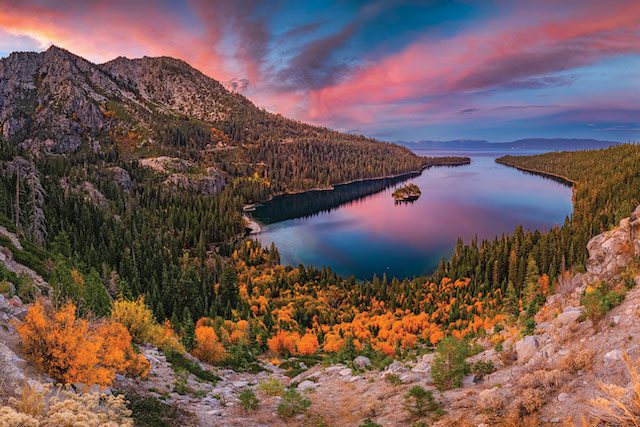
Ultra Natural showcases the perfect alignment of fall colors and sunset overlooking Emerald Bay
You’ve obviously branched out with your photography over the years. When did you begin to expand into other realms such as landscape and wildlife, and what inspired you to do so?
Marrying my wife in 2010, I realized that a vagabond life was not going to be conducive to settling down and starting a family. So, I began to explore landscape photography, as I had spent so many years in incredibly beautiful places but hardly ever photographed them without someone flying through the air or riding down some huge mountain. This allowed me to make my own schedule without the time constraints of editorial deadlines and production schedules.
On your website, you mention learning how to work with “nature’s dramatic and rare light that is often found in the mountains,” which brings to mind the late Galen Rowell and the question: Are there any photographers, famous or otherwise, who inspire you or stand out as personal favorites?
Galen Rowell was for sure a huge inspiration for me since he also started out as a dirtbag rock climber with a passion for the outdoors and beauty of nature, who was able to break out into an internationally respected photographer who transitioned into more landscape work as he matured into the legend that he was. Also, Jeff Mitchum, who I met on the shores of Mono Lake in 2012 and who had two very successful galleries in Las Vegas. He really took me under his wing and mentored me on the organic capture method that we both loved and the true business side of the gallery landscape photography industry and gave me my first true sales opportunities in his galleries.
When did you move to the Tahoe area, and what brought you here?
I moved to Truckee in 2012. My wife accepted a job with El Dorado County. I loved all my time couch surfing in Truckee before I met her and while we dated, and it seemed like a great place to base out of as a landscape photographer. I opened my first Truckee gallery about two years later. The rest is history.
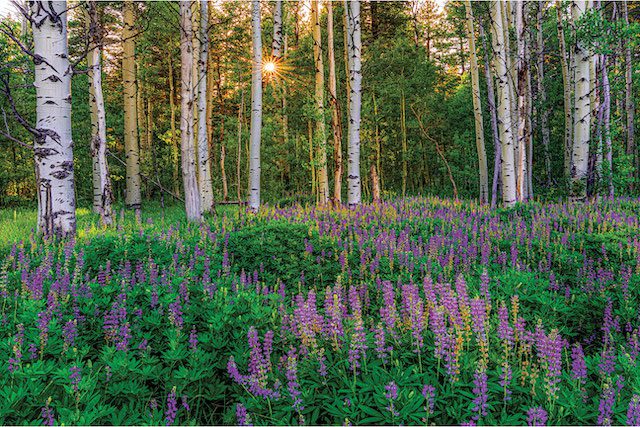
Luscious was taken in a favorite hidden spot near Tahoe where lupine bloom in the spring
As a professional photographer, what do you think are the advantages of being based in a place like Tahoe?
As a landscape photographer, I cannot think of many other places so perfectly balanced for landscape photography. So much diversity in terms of terrain and weather so close to home. Having the ability to just look out the window to see if I should go shoot photos is truly incredible. It allows me to be more of a family man than those landscape photographers who choose to live in larger cities and therefore need to travel great distances to find the beauty of nature.
You mention something interesting about your photography on your website, which is that you use your camera “as a painter would use their brush, focusing more on the mood and power of a pre-visualized scene before the camera even comes out of the bag.” Can you expand on this approach a little bit?
Yes, rather than trying to document what one might see with the naked eye, I like to use in-camera techniques that can change or manipulate the beauty into an image that is less re-creatable—a style that Ansel Adams was well known for. This requires a very intimate and deep knowledge of my camera and/or film as to the limits that the gear can go before crossing the line of impossible. I will often be out scouting scenes while thinking what would be the most incredible conditions and lighting that would make this location stand out and become art versus just a pretty picture of what someone would see.
In this modern age, photographers have access to a lot of editing tools and can even produce images that are deceivingly fake. Does that motivate you to do just the opposite—to produce images in your camera that require little editing on a computer?
Yes, I lean heavily on my deep knowledge of the science in photography, light and weather to create images that can be captured without much heavy editing or manipulation but require a high degree of patience and dedication. This method goes back to what I had mentioned earlier about working harder than others trying to achieve images that are hard to reproduce without hours of hard work and perseverance and deep knowledge of what my equipment can do. I feel that the last 20 years of photography have been some of the most exciting in the history of the industry. So much amazing technology, but a need for a strong moral compass has also been increased. But with that said, I do have a lot of respect for photographers who have harnessed many of the new capture methods and those who “make” images in the computer with their unique ability to pre-visualize what they want and how to capture the images to make these works of art.
As you answer these questions, you’re also preparing for your annual trip to Alaska to lead a bear photography workshop, correct? Tell us a little bit about this workshop as far as the location and photography.
A few years ago, I had the opportunity to revisit my summer job as a fly-fishing guide—but up in Alaska instead of central Oregon. Now I am the GM of two wilderness fly-out lodges and lead guide. I have taken this opportunity to pair that passion with my photography and lead bear photography trips out of our smaller lodge. We are located between Lake Clark National Park and Katmai National Park on the shores of Lake Iliamna, where the highest density of brown bears in the world live. This has provided a unique pairing of my skills to show people this incredible region where we can often see over 100 different bears a day in a truly wild environment and unspoiled part of the world. We fly out from the lodge every day in small float planes and either hike or take small rafts down rivers full of sockeye salmon, with bears feeding on the salmon running up the river.
Canon or Nikon—or another brand—and why?
I’ve been on the Nikon camera platform since 1999. I have utilized some other systems but never got rid of the Nikon equipment. The reason why is that it’s always just worked for me—a very large array of lenses, and up until recently, they haven’t changed the lens mount.
Where can readers find your work on display?
My work is locally represented at The Eadington Gallery in Tahoe City, all three Drink Coffee Do Stuff coffee shops (in Truckee, Incline Village and South Lake Tahoe) and on my website, abeblair.com.
What are your future goals with your photography?
My future plans for photography are to continue pushing both myself and knowledge of the art while also transitioning to a bit more teaching of photography through workshops and possibly opening another gallery if the opportunity presents itself.
Each year, Tahoe Quarterly editor Sylas Wright looks forward to seeing what Abe Blair has in store for the Best of Tahoe Photo Contest. He has never once been disappointed.



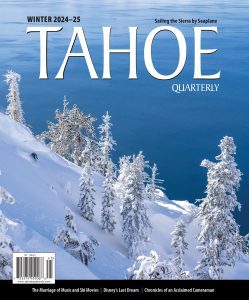
No Comments